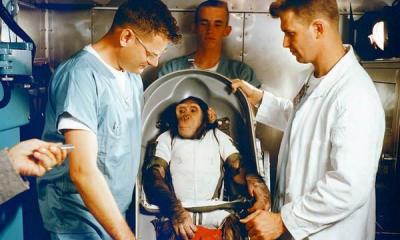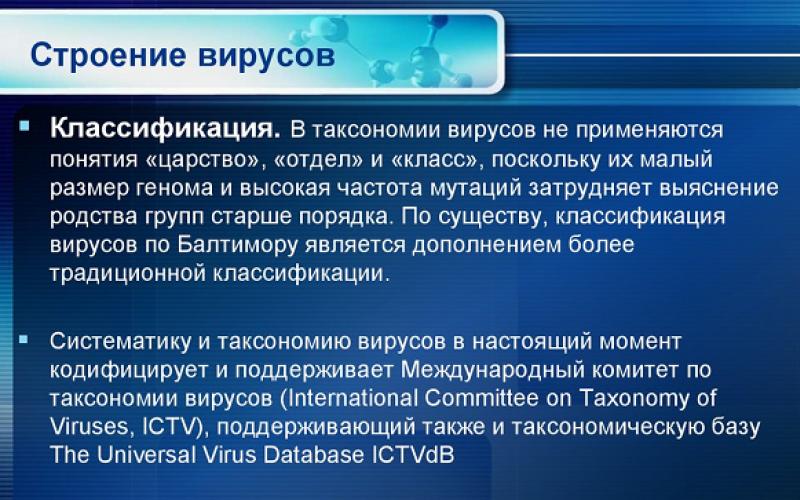Viruses appeared on Earth much earlier than humans and will remain on our planet even if humanity disappears. They are invisible, they cannot be heard or felt, but this does not mean that they do not exist. Viruses live both inside and outside of us. We learn about their existence (if it is not our job to study viruses) only when we get sick. And here it turns out that this little thing, which cannot even be seen with an ordinary microscope, can be very dangerous. Viruses cause a huge range of diseases from influenza and adenovirus infection to AIDS, hepatitis and hemorrhagic fever. And if representatives of other branches of biology in their daily work simply study their “wards”, then virologists and microbiologists are at the forefront of the struggle for human lives. What are viruses and why are they so dangerous?
1. According to one hypothesis, cellular life on Earth originated after the virus took root in bacteria, forming a cell nucleus. In any case, viruses are very ancient creatures.
2. Viruses are very easy to confuse with bacteria. In principle, at the household level, there is not much difference. And with those, and with others, we encounter when we are sick. Neither viruses nor bacteria are visible to the naked eye. But from the point of view of science, the differences between viruses and bacteria are very large. A bacterium is an independent organism, although it most often consists of a single cell. The virus does not even reach the cell - it's just a set of molecules in the shell. Bacteria cause harm side by side, in the process of existence, and for viruses, devouring an infected organism is the only way to live and reproduce.
3. Scientists are still arguing whether viruses can be considered full-fledged living organisms. Before entering living cells, they are as dead as stones. On the other hand, they have heredity. The titles of popular science books about viruses are characteristic: "Reflections and Debates on Viruses" or "Virus - Friend or Foe?"
4. Viruses were discovered in much the same way as the planet Pluto: at the tip of a pen. Russian scientist Dmitry Ivanovsky, while studying tobacco diseases, tried to filter out pathogenic bacteria, but he did not succeed. During microscopic examination, the scientist saw crystals that were clearly not pathogenic bacteria (these were accumulations of viruses, later they were named after Ivanovsky). Pathogenic agents died when heated. Ivanovsky came to a logical conclusion: the disease is caused by a living organism, invisible in an ordinary light microscope. And the crystals were able to isolate only in 1935. American Wendell Stanley in 1946 received the Nobel Prize for them.
5. Colleague Stanley American Francis Rous Nobel Prize had to wait even longer. Rous discovered the viral nature of cancer in 1911, and received the prize only in 1966, and even then, along with Charles Huggins, who had nothing to do with his work.
6. The word "virus" (Latin for "poison") was introduced into scientific circulation in the 18th century. Even then, scientists intuitively guessed that there are tiny organisms, the action of which is comparable to the action of poisons. The Dutchman Martin Bijerink, conducting experiments similar to those of Ivanovsky, called the invisible disease-causing agents "viruses".
7. Viruses were first seen only after the appearance of electron microscopes in the middle of the 20th century. Virology flourished. Viruses have been discovered by the thousands. The structure of the virus and the principle of its reproduction were described. To date, more than 6,000 viruses have been discovered. Most likely, this is a very small part of them - the efforts of scientists are concentrated on pathogenic viruses in humans and domestic animals, and viruses exist everywhere.
8. Any virus consists of two or three parts: RNA or DNA molecules, and one or two shells.
9. Microbiologists divide viruses into four types according to their shape, but this division is purely external - it allows you to classify viruses as spiral, oblong, etc. Also, viruses are divided into containing RNA (the vast majority) and DNA. There are seven types of viruses in total.
10. Approximately 40% of human DNA may be the remnants of viruses that have taken root in humans over many generations. There are also formations in the cells of the human body, the functions of which cannot be established. They can also be established viruses.

11. Viruses live and multiply exclusively in living cells. Attempts to introduce them, like bacteria, in nutrient broths have failed. And in relation to living cells, viruses are very picky - even within the same organism, they can live strictly in certain cells.
12. Viruses enter the cell either by destroying its wall, or by injecting RNA through the membrane, or by allowing the cell to absorb itself. Then the RNA copying process starts and the virus begins to multiply. Some viruses, including HIV, are selected from the infected cell without damaging it.
13. Almost all severe human viral diseases are transmitted by airborne droplets. The exceptions are HIV, hepatitis and herpes.
14. Viruses can be useful too. When rabbits became a national disaster in Australia, threatening all agriculture, it was a special virus that helped to cope with the eared invasion. The virus was brought into the places of accumulation of mosquitoes - for them it turned out to be harmless, and they infected the rabbits with the virus.
15. On the American continent, with the help of specially bred viruses, they successfully fight plant pests. Viruses that are harmless to humans, plants and animals are sprayed both manually and from aircraft.
16. The name of the popular antiviral drug Interferon comes from the word "interference". So called the mutual influence of viruses in the same cell. It turned out that two viruses in one cell are not always bad. Viruses can suppress each other. And interferon is a protein that can distinguish a “bad” virus from a harmless one and act only on it.
17. Back in 2002, the first artificial virus was obtained. In addition, more than 2,000 natural viruses have been fully deciphered and scientists can recreate them in the laboratory. This opens up great opportunities both for obtaining new drugs and developing new methods of treatment, and for creating very effective biological weapons. An outbreak of a banal and, as it was declared, long defeated smallpox in the modern world is capable of killing millions of people due to lack of immunity.
18. If we consider the mortality from viral diseases in a historical perspective, the medieval definition of viral diseases as the scourge of God becomes clear. Smallpox, plague and typhus regularly halved the population of Europe, destroying entire cities. The American Indians were exterminated not by regular army units and not by brave cowboys with Colts in their hands. Two-thirds of the Indians died of smallpox, which vaccinated civilized Europeans infected goods sold to the redskins. At the beginning of the 20th century, from 3 to 5% of the world's inhabitants died from influenza. The AIDS epidemic is unfolding, despite all the efforts of doctors, before our eyes.
19. To date, filoviruses are the most dangerous. This group of viruses was discovered in the countries of equatorial and southern Africa after a series of outbreaks of hemorrhagic fevers - diseases during which a person quickly becomes dehydrated or bleeds. The first outbreaks were recorded in the 1970s. The average mortality in hemorrhagic fevers is 50%.
20. Viruses are a fertile topic for writers and filmmakers. The plot of how an outbreak of an unknown viral disease destroys a lot of people was played by Stephen King and Michael Crichton, Kir Bulychev and Jack London, Dan Brown and Richard Matheson. There are dozens of films and series on the same topic.








